The Friends of the Wildflower Garden, Inc.
Trees and Shrubs of the Eloise Butler Wildflower Garden
The oldest public wildflower garden in the United States
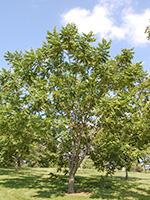
Common Name
Butternut (White Walnut)
Scientific Name
Juglans cinerea L.
Plant Family
Walnut (Juglandaceae)
Garden Location
Woodland
Prime Season
Late Spring Flowering; Early Autumn Fruit
Butternut is a native, erect, small to medium size tree, growing 40 to 70 feet, with a broad open crown. There is some toxicity effects on other plants - see bottom section of this page.
Bark is a light gray, smooth initially, becoming rough and furrowed with age. Furrow ridges have flat shiny tops and the furrowing is in a sort of diamond pattern (not unique).
Twigs are yellow-brown or reddish-brown to gray, stout with sticky glandular hair, a chambered pith and a fringe of hair above the upper ridge of the leaf scar (unlike Black Walnut). The leaf scare has 3 lobes of a shield shape - resembling a so called "monkey face" - with the hair creating the appearance of an eyebrow. Buds are large and have a few light colored scales with fine hair. Terminal buds are flattened on the long axis.
Leaves: The leaf is large, long (up to 24 inches) compound, with 11 to 17 (11 - 19) leaflets, a stout stalk and a central rib (rachis) which is hairy. The leaflets are lance-shaped, pointed at the tip, stalkless (unlike Black Walnut), unequal symmetrically, green on top, pale under due to much dense branched hair. Leaflet margins have fine teeth. Unlike Black Walnut, the terminal leaflet is present and well formed. Fall color is yellow to brown.
Flowers: The tree is monoecious, that is the male and female flowers are separate, appearing with the leaves but usually at different times on the same tree. Male flowers are hanging catkins, up to 5 inches long, yellow green in color, encircled with many small flowers, each flower bearing 7 to 15 (8 - 12) stamens. These occur at the tip of last years twig. Female flowers occur 6 to 8 together near the end of a new twig on a short spike and are also yellow-green in color. They have a two-lobed reddish style.
Fruit: Flowers mature to a cluster of 3 to 5 oblong sticky nuts with a yellow-green husk which contains an irregularly shaped 2-celled nut that has edible, oily meat. The husks do not open by themselves at maturity.
Habitat: Butternut grows from wide-spreading lateral roots and usually develops a taproot. It grows in rich woods with good drainage and full sun. It is not tolerant of shade and is short-lived compared to the Black Walnut. Trees need 12 to 20 years to produce any quantity of nuts.
Names: For the genus, Juglans, Mrs Grieve (Ref.#7) has the best derivation: "It is said that in the 'golden age' when men lived upon acorns the gods lived upon Walnuts, and hence the name of Juglans, Jovis glans, or Jupiter's nuts." The species, cinerea, means 'ash colored', as is the bark and the nut husk. The author name for the plant classification, 'L.', refers to Carl Linnaeus (1707-1778), Swedish botanist and the developer of the binomial nomenclature of modern taxonomy.
Comparisons: The closest confusing species is J. nigra, Black Walnut. There the leaflets are more in number and stalked, the terminal leaflet usually missing, the nut husk is more round in shape and is usually solitary or 2 together, and the leaf scar does not have a row of hair on the upper ridge.
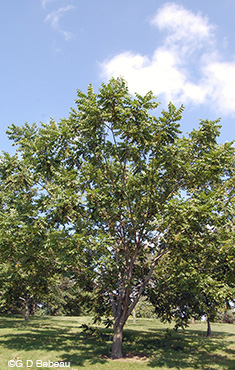
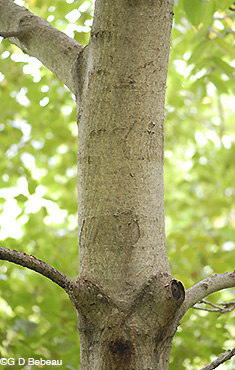
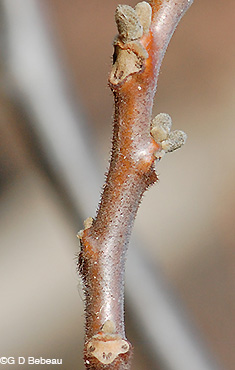
Above: 1st photo - Butternuts have a broad open crown and less height than walnuts. 2nd photo - Bark is a light gray, smooth initially, as shown above, becoming rough and furrowed with age. 3rd photo - The leaf scar on twigs has 3 lobes of a shield shape - resembling a so called "monkey face" and with the hair on the upper ridge that appears to be an eyebrow. The glandular hair of the twig is visible in the photo.
Below: 1st & 2nd photos - Examples of very old bark. The tree is quite large (and old) for a butternut. 3rd photo - Former gardener Cary George does a ring count on a 100 year tree that was downed in a storm on June 23, 2003 - which, based on age, must be one of the trees planted by Eloise Butler.
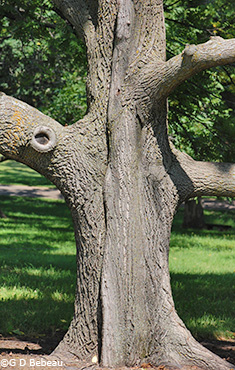
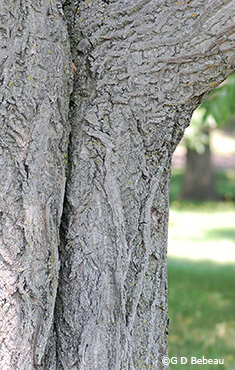
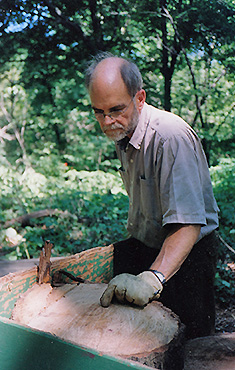
Below: 1st photo - Fall twigs are stout with sticky hair. Buds are large and have a few light colored scales with fine hair. Terminal buds are flattened on the long axis. 2nd photo - Twigs in spring take on a yellowish tone.
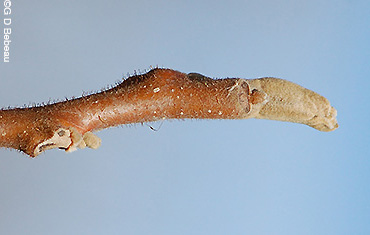
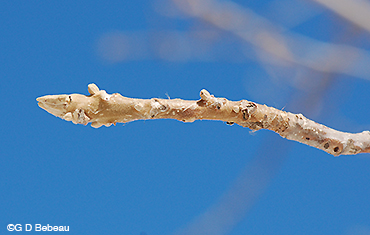
Below: 1st photo - The compound leaf has 11 to 17 (11 - 19) leaflets, a stout stalk and a central rib (rachis) which is hairy. 2nd photo - The underside - note the unequal symmetry from side to side.

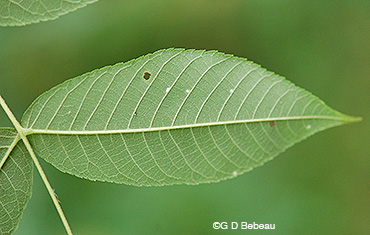
Below: Male flowers - 1st photo - catkins forming at the tip of last year's twig. 2nd photo - male catkins extended to expose the stamens. 3rd photo - Female flowers occur in a tight cluster at the tip of new growth.
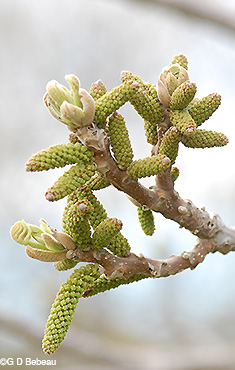
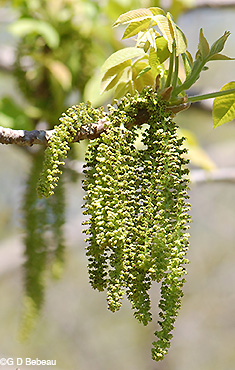
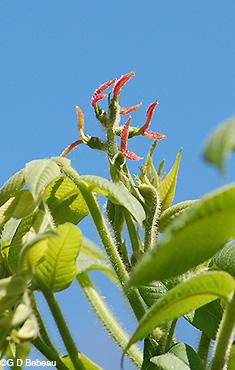
Below: 1st photo - Stamens are covered by a greenish-brown bract. 2nd photo - The female flower is yellowish-green with a reddish 2-lobed style.
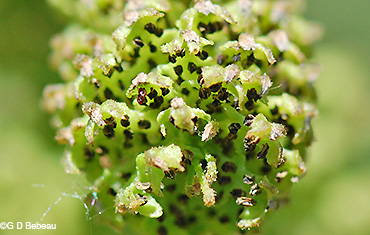
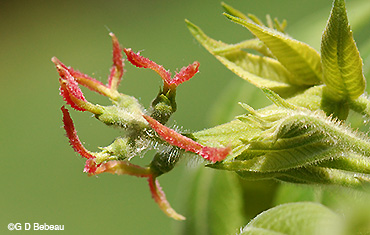
Below: Flowers mature to a cluster of 3 to 5 oblong, sticky, nuts with a yellow-green husk which contains an irregularly shaped 2-celled nut that has edible, oily meat. The husks do not open by themselves.
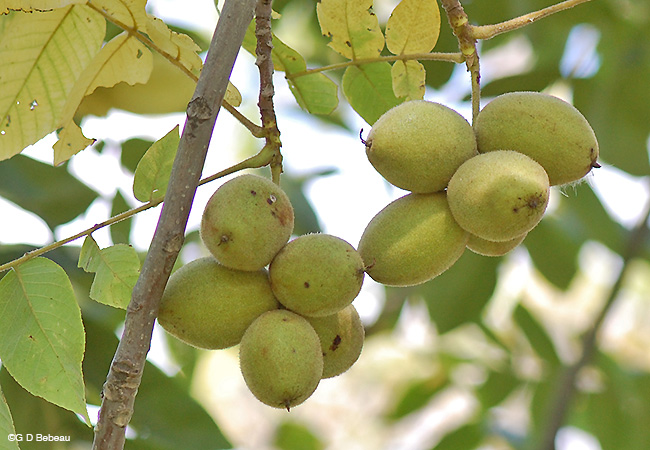
Below: This larger tree is in Wirth Park north of the Garden.
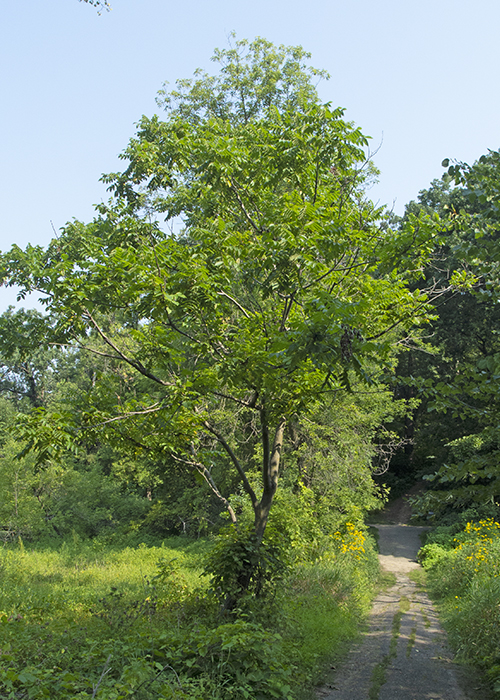
Notes: Butternut or White Walnut is not indigenous to the Garden. Eloise Butler first planted it in May 1909 with plants obtained from the Park Board Nursery; again in 1910 from the same source and in 1911 from Strand's Nursery in Taylor's Falls, MN, others in 1915. Martha Crone planted it in 1949 and Ken Avery in 1977. In North America the plant ranges from the central plains eastward, excepting only the Canadian maritime provinces and the U.S. states of Louisiana and Florida. Within Minnesota its range is restricted to the eastern half of the state, east of a line from Cass county on the north to Brown and Blue Earth on the south. It was native to most metro counties but is now so rare in the wild that it is listed on the MN DNR "Endangered List".
Butternut is subject to a fungal pathogen, the Butternut canker (Sirococcus clavigignemti-julandacearum), which was introduced to North America and first noticed in our area in 1967. It eventually kills most trees but does not infect the Black Walnut.
Uses: Butternut wood is much lighter than Black Walnut, but works easily with tools. It has been used in furniture and interior decoration but because of the scarcity of harvest-able trees it does not have much current use. Around the early 1900s it was much in use in Minnesota for interior trim in finer houses. Because large trees rarely reach 75 years of age, large pieces of lumber are not found even in specialty lumber yards. In former time periods when they were more abundant the nuts were used in baking, much like walnuts are today. The fruit husks will make a yellow and orange dye.
Toxicity: Butternut, like the Black Walnut, produces a chemical, juglone, that is toxic to certain plants growing in or close to the root zone. These include tomato, potato, apple, lilacs, rhododendrons and peppers.
Return to -- Site Plan/Archive Index --or-- List of Common Plant Names -- or -- List of Scientific Names -- or --Home Page - - - Back to top.
References: Plant characteristics are generally from sources 1A, 32, W2, W3, W7 & W8 plus others as specifically applied. Distribution principally from W1, W2 and 28C. Planting history generally from 1, 4 & 4a. Other sources by specific reference. See Reference List for details.
 Identification booklet for most of the flowering forbs and small flowering shrubs of the Eloise Butler Wildflower Garden. Details Here.
Identification booklet for most of the flowering forbs and small flowering shrubs of the Eloise Butler Wildflower Garden. Details Here.
©2015
Friends of the Wildflower Garden, Inc. Text and photos are by G. D. Bebeau unless otherwise credited. "www.friendsofeloisebutler.org"
051020